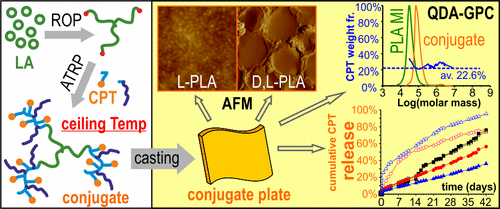当前位置:
X-MOL 学术
›
Macromolecules
›
论文详情
Our official English website, www.x-mol.net, welcomes your
feedback! (Note: you will need to create a separate account there.)
ATRP of Methacrylic Derivative of Camptothecin Initiated with PLA toward Three-Arm Star Block Copolymer Conjugates with Favorable Drug Release
Macromolecules ( IF 5.1 ) Pub Date : 2017-08-31 00:00:00 , DOI: 10.1021/acs.macromol.7b01350 Andrzej Plichta 1 , Sebastian Kowalczyk 1 , Krzysztof Kamiński 1 , Monika Wasyłeczko 1 , Stanisław Więckowski 1 , Ewa Olędzka , Grzegorz Nałęcz-Jawecki , Anna Zgadzaj , Marcin Sobczak
Macromolecules ( IF 5.1 ) Pub Date : 2017-08-31 00:00:00 , DOI: 10.1021/acs.macromol.7b01350 Andrzej Plichta 1 , Sebastian Kowalczyk 1 , Krzysztof Kamiński 1 , Monika Wasyłeczko 1 , Stanisław Więckowski 1 , Ewa Olędzka , Grzegorz Nałęcz-Jawecki , Anna Zgadzaj , Marcin Sobczak
Affiliation

|
Three-arm polylactides (PLA) containing 0.2, 7.6, and 13% of d-lactic acid monomeric units were obtained and refunctionalized into ATRP macroinitiators via esterification of hydroxyl groups with 2-bromoisobutyryl bromide. These polymeric matrices underwent enzymatic degradation with various rates and revealed negative results on cytotoxicity and genotoxicity tests. Camptothecin (CPT), which is an anticancer active substance, was transformed into acrylic monomers; however, simple CPT acrylate was not able to polymerization whereas methacrylate with a linker was ready for FRP and ATRP. The latter monomer was used for ATRP initiated with various PLA macroinitiators in order to form block copolymer conjugates of CPT with high load of drug. Based on kinetic studies at various temperatures, it was found out that the polymerization stopped at certain monomer conversion because of the ceiling temperature. The content of CPT in these conjugates was estimated by means of 1H NMR, quadruple detection array GPC, and elemental analysis and was in the range 8.0–16.9 wt %. The products were morphologically heterogeneous, and the shapes and size of the nano-/microstructures were influenced by crystallinity of the PLA segment which was shown in AFM images. Terpolymer block conjugates consisting of addition PEGMA monomeric units were synthesized as well in order to increase hydrophilicity of the polymers and to protect a lactone ring in CPT structure. The studies on CPT release were carried out in vitro and revealed that the rate of CPT discharge was influenced by the structure of PLA and conjugate composition; however, it was near to zero-order kinetics. The analysis using the Korsmeyer–Peppas model suggests that drug release was governed rather according supercase II transport (n > 1) which shows that it is a highly controlled process.
中文翻译:

PLA引发的喜树碱甲基丙烯酸衍生物对三臂星形嵌段共聚物的ATRP与有利的药物释放共轭
三臂聚乳酸(PLA)含有d的0.2%,7.6%和13%获得了β-乳酸单体单元,并通过羟基与2-溴异丁酰溴的酯化反应将其重新官能化为ATRP大分子引发剂。这些聚合物基质经历了各种速率的酶降解,并显示出对细胞毒性和遗传毒性测试的负面结果。喜树碱(CPT)是一种抗癌活性物质,已转化为丙烯酸单体。但是,简单的CPT丙烯酸酯不能聚合,而带有连接基的甲基丙烯酸酯可用于FRP和ATRP。后者单体用于由各种PLA大分子引发剂引发的ATRP,以形成具有高载药量的CPT嵌段共聚物共轭物。基于在各种温度下的动力学研究,发现由于上限温度,聚合在一定的单体转化率下停止。1 H NMR,四重检测阵列GPC和元素分析范围为8.0-16.9 wt%。产物在形态上是异质的,并且纳米/微结构的形状和尺寸受AFM图像中显示的PLA链段的结晶度的影响。还合成了由加成的PEGMA单体单元组成的三元共聚物嵌段共轭物,以增加聚合物的亲水性并保护CPT结构中的内酯环。在体外进行了CPT释放的研究,结果表明CPT的释放速率受PLA结构和结合物组成的影响。但是,它接近零级动力学。使用Korsmeyer-Peppas模型进行的分析表明,药物释放的控制方式取决于supercase II的运输方式(n > 1),这表明它是一个高度受控的过程。
更新日期:2017-08-31
中文翻译:

PLA引发的喜树碱甲基丙烯酸衍生物对三臂星形嵌段共聚物的ATRP与有利的药物释放共轭
三臂聚乳酸(PLA)含有d的0.2%,7.6%和13%获得了β-乳酸单体单元,并通过羟基与2-溴异丁酰溴的酯化反应将其重新官能化为ATRP大分子引发剂。这些聚合物基质经历了各种速率的酶降解,并显示出对细胞毒性和遗传毒性测试的负面结果。喜树碱(CPT)是一种抗癌活性物质,已转化为丙烯酸单体。但是,简单的CPT丙烯酸酯不能聚合,而带有连接基的甲基丙烯酸酯可用于FRP和ATRP。后者单体用于由各种PLA大分子引发剂引发的ATRP,以形成具有高载药量的CPT嵌段共聚物共轭物。基于在各种温度下的动力学研究,发现由于上限温度,聚合在一定的单体转化率下停止。1 H NMR,四重检测阵列GPC和元素分析范围为8.0-16.9 wt%。产物在形态上是异质的,并且纳米/微结构的形状和尺寸受AFM图像中显示的PLA链段的结晶度的影响。还合成了由加成的PEGMA单体单元组成的三元共聚物嵌段共轭物,以增加聚合物的亲水性并保护CPT结构中的内酯环。在体外进行了CPT释放的研究,结果表明CPT的释放速率受PLA结构和结合物组成的影响。但是,它接近零级动力学。使用Korsmeyer-Peppas模型进行的分析表明,药物释放的控制方式取决于supercase II的运输方式(n > 1),这表明它是一个高度受控的过程。











































 京公网安备 11010802027423号
京公网安备 11010802027423号